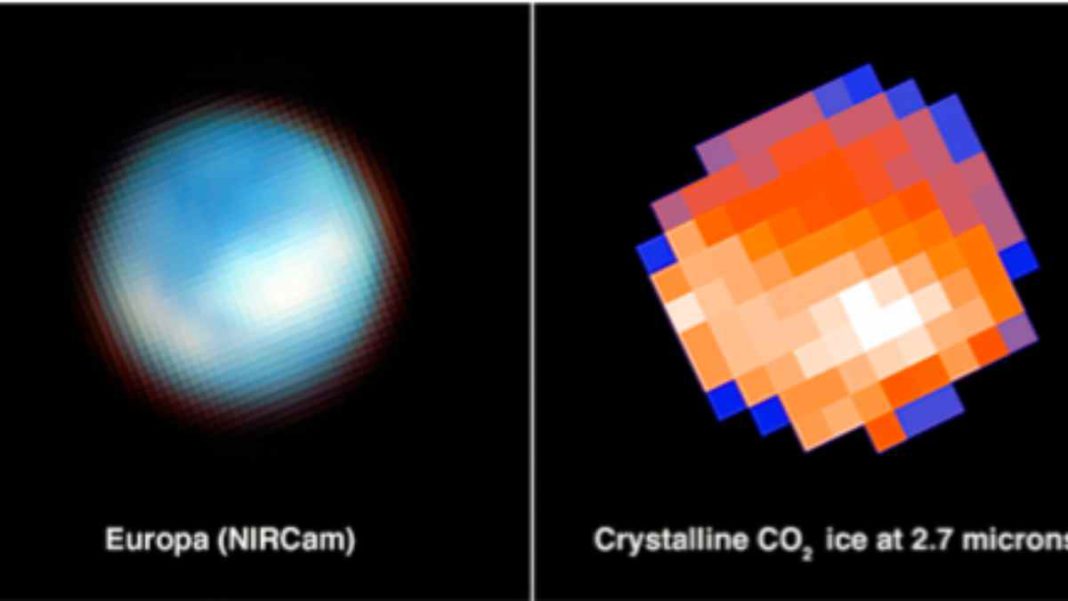UNITED STATES: Astronomers using NASA’s James Webb Space Telescope have uncovered strong evidence of carbon dioxide (CO2) on the surface of Jupiter’s moon, Europa. This discovery could signify a vital step forward in understanding the moon’s habitability and its potential to support life beyond Earth.
Europa, with its icy exterior concealing a vast subsurface ocean, has long captivated planetary scientists’ imaginations. The primary question that has lingered is whether the moon’s internal ocean contains the crucial chemicals needed for life to thrive, particularly carbon.

Now, thanks to data collected by the James Webb Space Telescope, scientists have identified carbon dioxide on the surface of Europa, which is believed to have originated from the moon’s subsurface ocean. This finding is groundbreaking because carbon is a fundamental building block of life as we know it on Earth.
The carbon dioxide appears to be most concentrated in a region known as Tara Regio, characterized by geologically youthful terrain with disrupted features called “chaos terrain.” This concentration strongly suggests that there has been a dynamic exchange of materials between Europa’s subsurface ocean and its icy surface in this specific area.
“Carbon is a biologically essential element on Earth. Life thrives on chemical diversity, and carbon is at the heart of that diversity. This discovery gives us crucial insights into the potential habitability of Europa’s ocean,” says Geronimo Villanueva of NASA’s Goddard Space Flight Center, the lead author of one of the two independent papers detailing these findings.
Samantha Trumbo of Cornell University, the lead author of the second paper, echoes this sentiment, “We now think that we have observational evidence that the carbon we see on Europa’s surface came from the ocean. That’s not a trivial thing.”
The carbon dioxide’s presence on Europa’s surface provides tantalizing hints about the connection between the moon’s ocean and its exterior. Scientists have long debated the extent of this connection, but this discovery suggests that critical information about the ocean’s composition may be deciphered without the need to drill through the moon’s icy shell.
The identification of carbon dioxide was made possible by NASA’s Webb telescope’s Near-Infrared Spectrograph (NIRSpec), which provided detailed spectra with remarkable resolution. Europa’s surface, with a diameter of 1,944 miles, was scrutinized with unprecedented precision.
It is important to note that carbon dioxide is not stable on Europa’s surface, which suggests that it was likely supplied relatively recently in geological terms. This conclusion is bolstered by its concentration in a region known for its youthful terrain.
Furthermore, the James Webb Space Telescope’s data also offered insights into another intriguing aspect of Europa – the search for plumes of water vapor erupting from its surface. Previous tentative detections of these plumes were reported using the Hubble Space Telescope. However, the new Webb data did not reveal any evidence of plume activity during its observations, allowing scientists to set strict upper limits on potential material ejections.
Heidi Hammel of the Association of Universities for Research in Astronomy, a key figure in Webb’s observations of the solar system, noted, “Even with this short period of time, we were able to do really big science. This work gives a first hint of all the amazing solar system science we’ll be able to do with Webb.”
These groundbreaking findings are poised to inform future space missions. NASA’s Europa Clipper spacecraft, scheduled for launch in October 2024, aims to conduct close flybys of Europa to further investigate its potential habitability. The European Space Agency’s Jupiter Icy Moons Explorer (JUICE) mission will also benefit from these discoveries as it explores the mysteries of the Jovian system.
Also Read: NASA’s OSIRIS-REx to Cap Off Epic Mission with Daring Descent and Desert Touchdown



